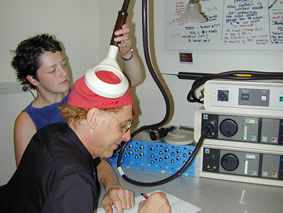We are fascinated by human creativity and by the critical
role of the nonconscious mind in initiating our most profound creative advances. We are presently embarking on a series
of exciting experiments to gain access to the
nonconscious mind and to enhance human creativity.
Nonconscious problem solving is crucial to the creative
process. In this project we aim to tap into and characterise
nonconscious brain processes and amplify them, so that we
may also enhance creativity.
This project requires a multidisciplinary approach which
integrates psychophysiology, brain scanning, and behavioural
and psychological analysis and we have many collaborators
working with us to achieve our goals. |
| |
How do we identify nonconscious processes? |
| |
|

|
Transcranial
magnetic stimulation (TMS) is used to inhibit or activate
different regions of a person's brain. While the stimulus
is applied, we test the person's skills and behaviour in
different areas, which require cognitive processing. This
reveals to us what cognitive effects the stimulation is
having on the person. Preliminary studies indicate that,
using this technique, savant skills can amazingly be switched
on in normal people!
We believe that an improvement in savant-like skills indicates
that the person has heightened access to their nonconscious
brain mechanisms and we can identify these by studying brain
maps taken before and after the stimulation using EEG. |
| |
Where is this research going? |
| |
|
Essentially, we aim to develop a system whereby a person
can access and enhance processes in their own nonconscious
mind. We envisage a system one day where a person can engage
in direct communication with a computer or machine that
can literally read their mind. We believe this will be the
next crucial and critical step in the IT revolution and
will lead to further amazing technological advances. |
| |
Enhancing Creativity |
| |
|
Clearly nonconscious problem solving is crucial to the
creative process.
So, what if we could somehow access the nonconscious mind
without the expense of losing our mindsets?
In our present research projects we are exploring and attempting
to characterise this phenomenon quantitatively by carefully
controlled experiments in several domains. We have adopted
a multidisciplinary approach which integrates psychophysics,
brain scanning and behavioural techniques on both normal
as well as on brain damaged individuals. |
| |
|
|
In the 1999 New Scientist cover story about
our research, Prof Snyder first voiced his controversial
suggestion that by using magnetic stimulation to temporarily
switch off parts of the conscious mind we would be
able to gain access to the nonconscious mind, with
the result that for that short time we would see the
world in a whole new way - a savant-like way.
A critique of this paper appeared in Nature
News and Views, and here it was suggested that EEG
assisted biological feedback could also be used as
a means of circumventing conscious brain processing
to gain direct access to the nonconscious mind.
We are now embarking on a number of exciting research
projects in our attempt to access the nonconscious
mind and enhance creativity. |
 |
|
|
|

